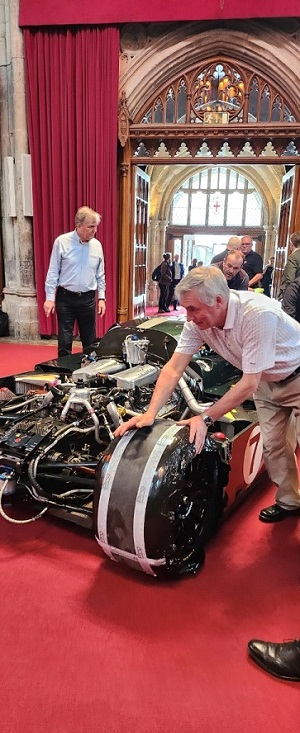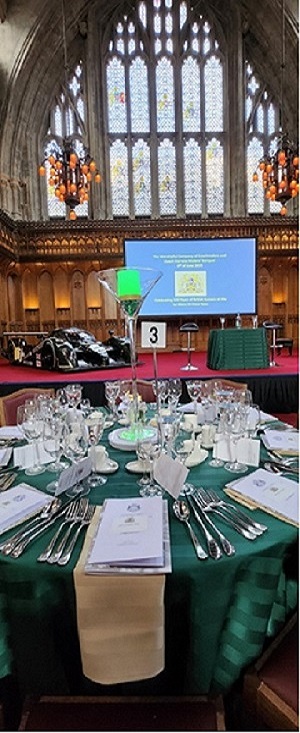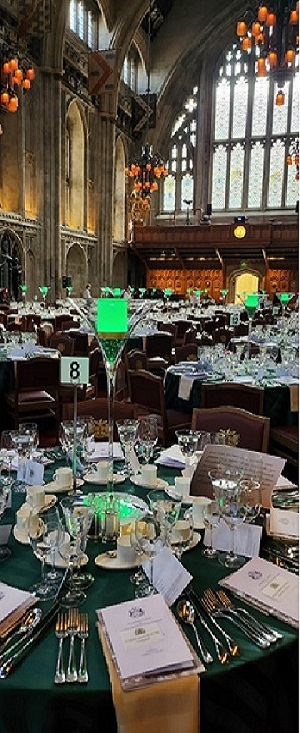
Tel: 020 7620 1818 email: cookandbutler@btconnect.com
The Worshipful Company of
Coachmakers
and
Coach Harness Makers of London
www.coachmakers.co.uk
The January Court
Masters' And Clerks' Luncheon
23rd January 2025, Armourers' Hall, London


The Banquet, Marking
the Centenary Year of The Fleet Air Arm
17th May 2024, Guildhall, London
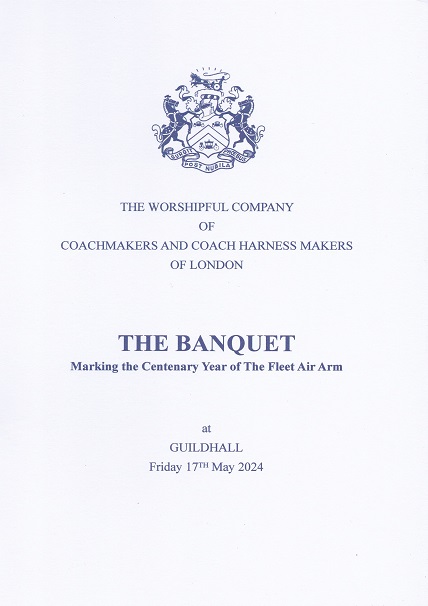
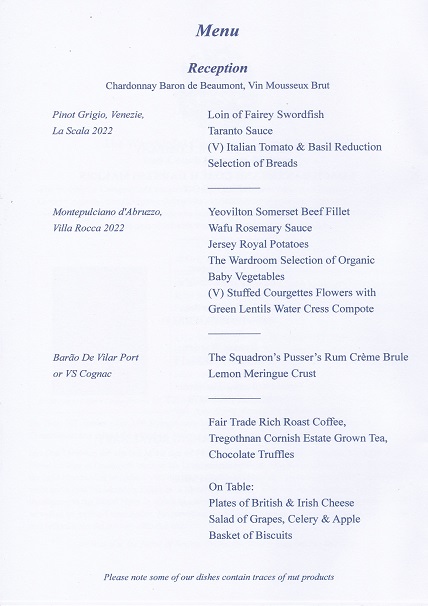
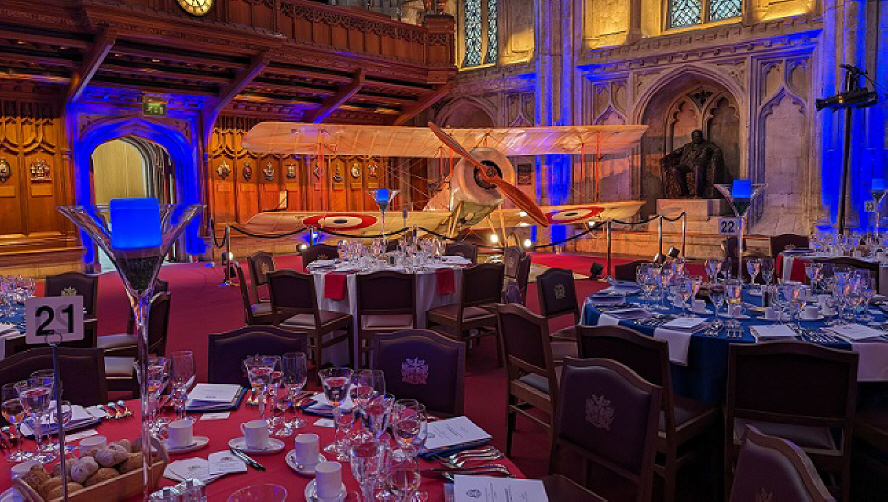
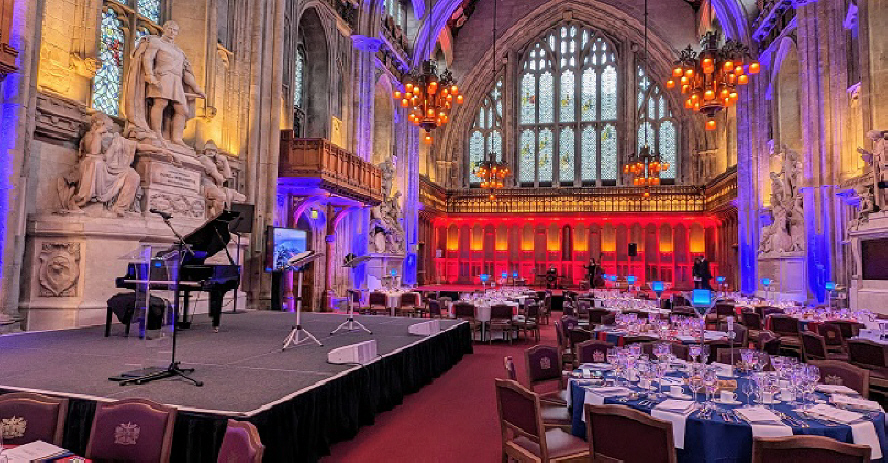
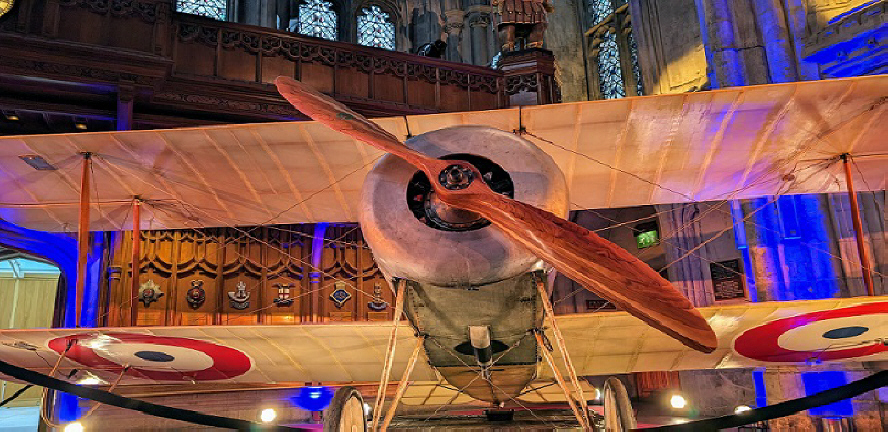
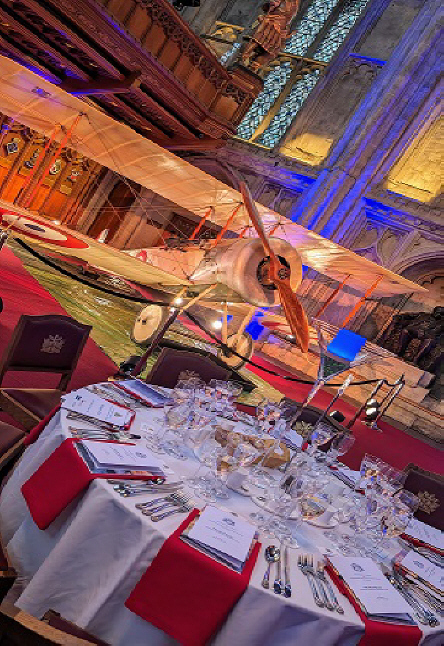
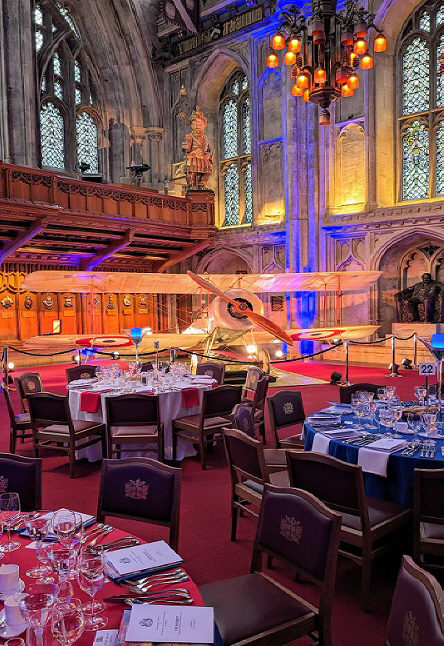
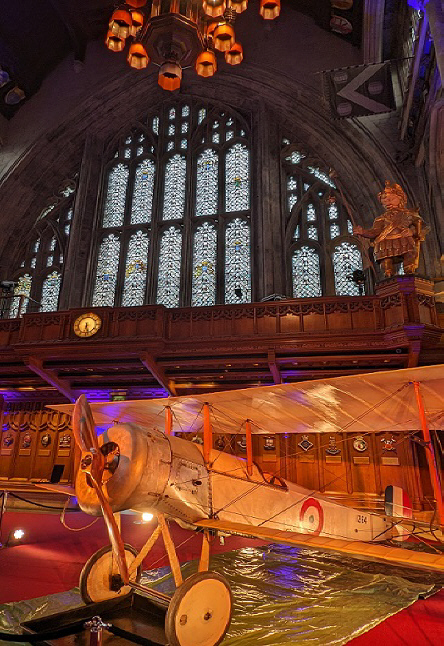
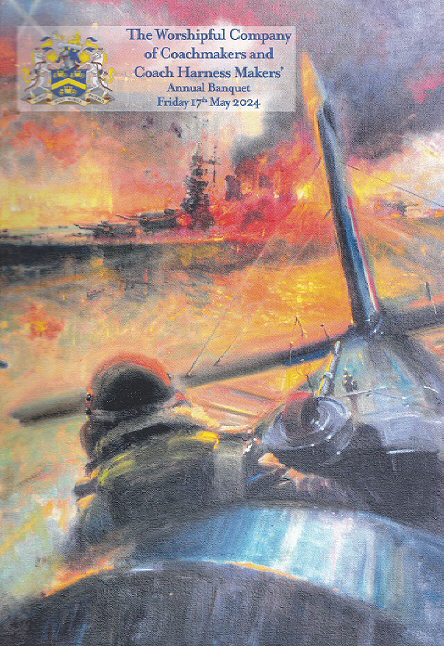
![]()
The Masters' And
Clerks' Luncheon
7th December 2023, Watermen's Hall, London
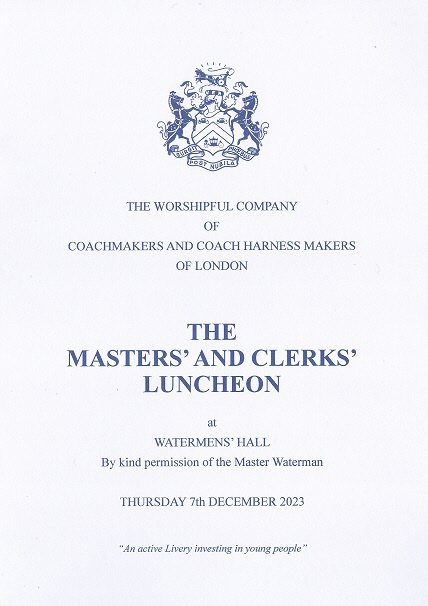
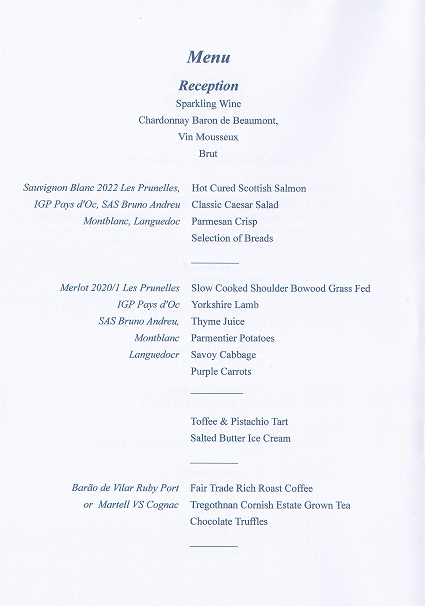
![]()
Celebrating
British success during 100 years of the Le Mans 24 Hour Race
Tuesday 6th June 2023, Guildhall, City of London
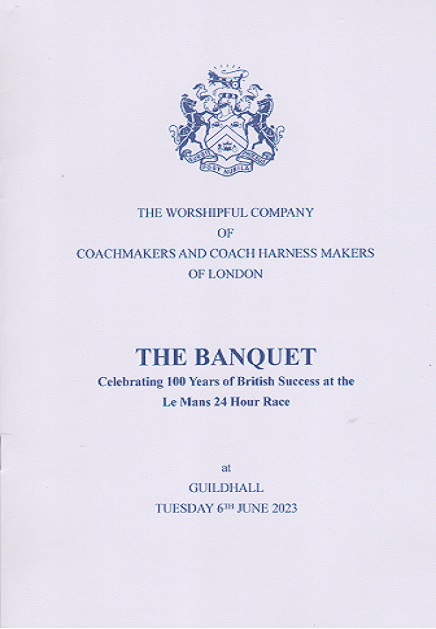
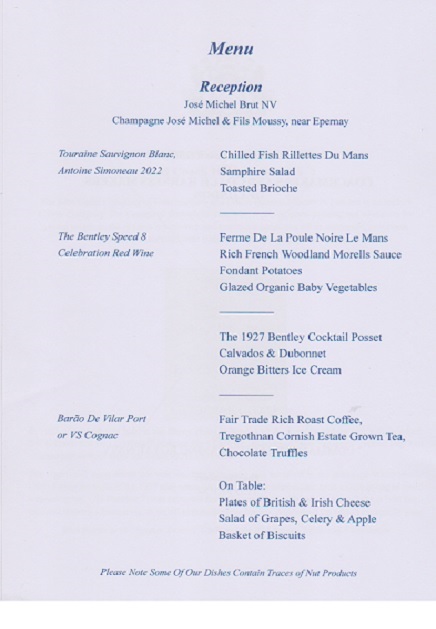
The Clerk brings in the Top Table Guest
The Banquet
8th
June 2022, Guildhall, City of London
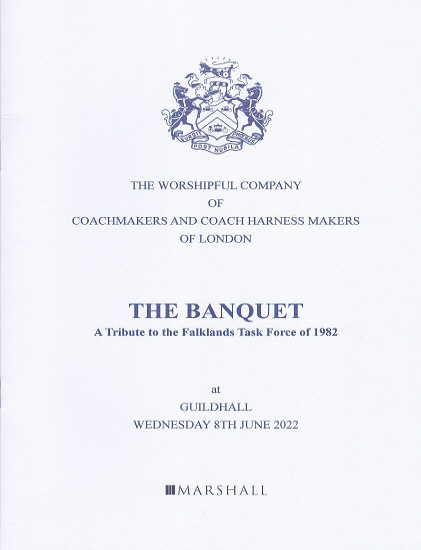
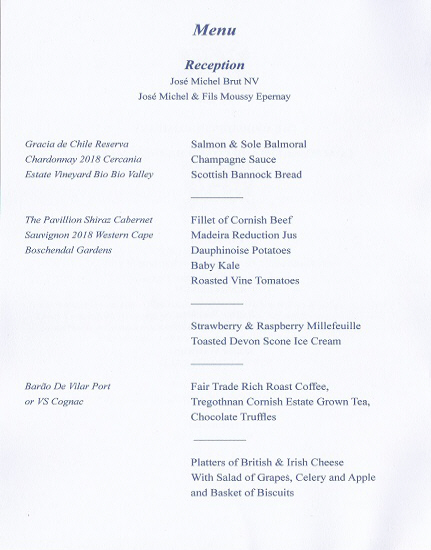

City Livery Banquet
June 2019, Guildhall, City of London
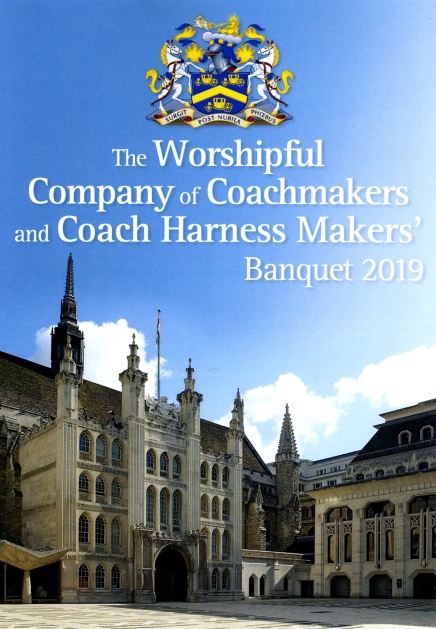
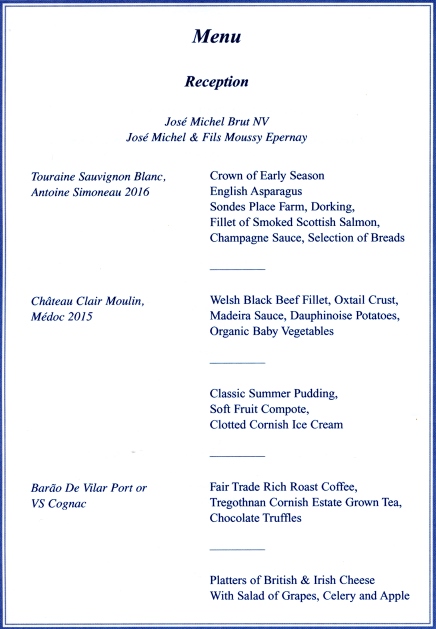
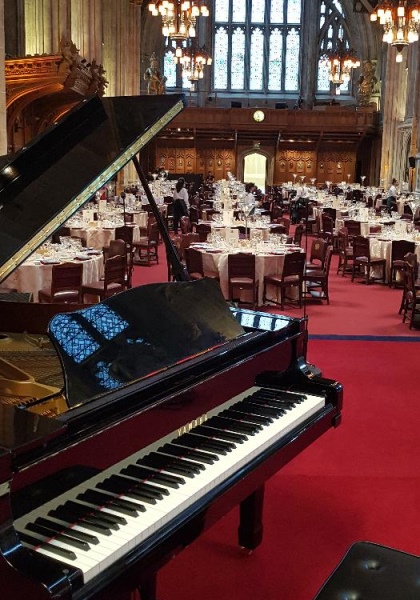
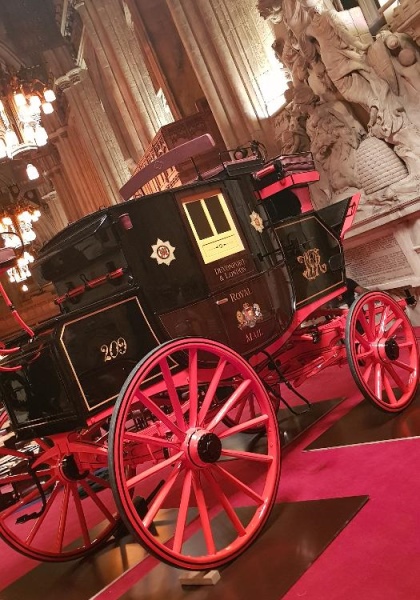
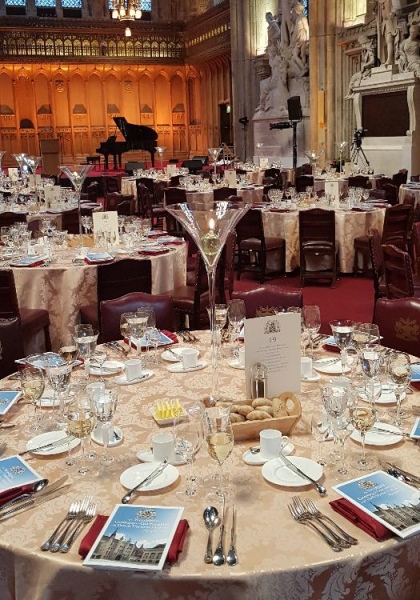
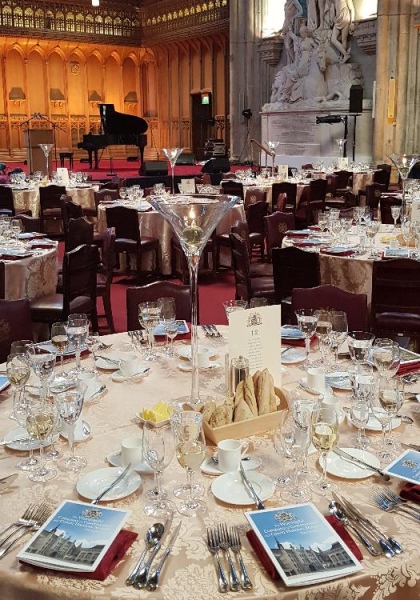
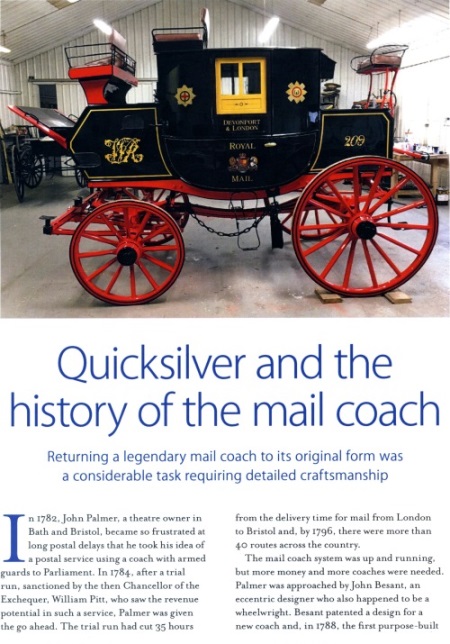
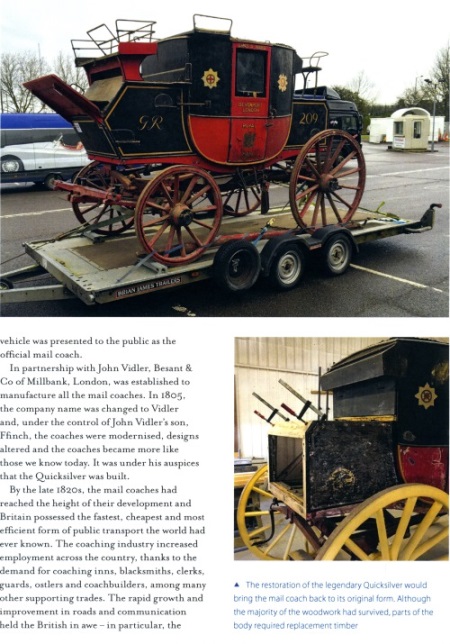
Quicksilver and the history of the mail coach
In I782, John Palmer, a theatre owner in Bath and Bristol,
became so frustrated at long postal delays that he took his idea of a postal
service using a coach with armed guards to Parliament. In 1784, after a
trial run, sanctioned by the then Chancellor of the Exchequer, William Pitt,
who saw the revenue potential in such a service, Palmer was given the go
ahead. The trial run had cut 35 hours from the delivery time for mail from
London to Bristol and, by I796, there were more than 40 routes across the
country.
The mail coach system was up and running, but more money and more coaches
were needed Palmer was approached by John Besant, an eccentric designer who
also happened to be a wheelwright. Besant patented a design for a new coach
and, in I788, the first purpose-built vehicle was presented to the public as
the official mail coach.
In partnership with John Vidler, Besant & Co of Millbank, London, was
established to manufacture all the mail coaches. In 1805, the company name
was changed to Vidler and, under the control of John Vidler’s son, Ffinch,
the coaches were modernised, designs altered and the coaches became more
like those we know today. It was under his auspices that the Quicksilver was
built.
By the late 1820s, the mail coaches had reached the height of their
development and Britain possessed the fastest, cheapest and most efficient
form of public transport the world had ever known. The coaching industry
increased employment across the country, thanks to the demand for coaching
inns, blacksmiths, clerks, guards, ostlers and coachbuilders, among many
other supporting trades. The rapid growth and improvement in roads and
communication held the British in awe - in particular, the mail coaches,
known as ‘The Mails’, with their record of speed, punctuality and smartness.
No other country could match its excellence and, according to the British,
‘it was perfection’.
The mail coach routes were organised by numbers, the most famous being the
London to Devonport mail, number 209. This was the fastest long-distance
mail in the country, and also one of the most important, bringing back news
from the naval ports. A distance of 215 miles took 21.5 hours, including
stops for changing mailbags and horses.
LEGENDARY STATUS
The mail coach commanded a legendary status among the
public. It is said that people set their watches by the mail, as it was so
accurate. Timing had never been that precise before the mail coach system.
The guard, who was in charge of the coach, would be fined if the mail was
late. It became a legend in its own lifetime, the only mail coach out of
hundreds covering the country to be given a name to capture its fame, speed
and panache: the Quicksilver.
The Devonport Mail, Quicksilver, by Vidler, was almost 200 years old when it
ended its service at the close of the year 1835.
After it was taken off the road, it was acquired by Jack Stracey, an early
member of the Coaching Club during the early coaching revival period (1850
onwards). As with many retired mail coaches, it was altered and turned into
a private coach, or park drag. It was passed on to Stracey's nephew, another
coaching enthusiast, Edward Stacey Clitheroe, who inherited Hotham Hall in
East Yorkshire in 1865, where he kept the coach.
Quicksilver ended up in the Hull Museum of Transport, among a carriage
collection, having been turned back to resembling a mail coach, albeit
rather incorrectly. It was then sold in the 1970s to a private buyer and
stored away, until his death, whereupon it was sold in an auction of classic
cars by Bonhams in 2015.
Quicksilver was bought by Portia Kennaway, a liveryman of the Worshipful
Company of Coachmakers, for her fine collection, and more importantly, to
keep it in the UK. Portia consigned the coach to fellow Liveryman and
Steward, Mark Broadbent of Fenix Carriages, to undertake its complete
restoration.
As Mark had restored other carriages for Portia, she was well aware of his
enthusiasm, fastidious attention to detail and desire to get things right.
This was an enormous task, and one of the most exciting projects ever
undertaken by Fenix Carriages. Mark went to tremendous lengths to research
and investigate Vidler’s history and work. This was made even more
interesting when he met David Honour, who has spent a lifetime researching
and studying Vidler. His input and extensive archive collection has
unearthed detailed facts, which have resulted in a finished article as true
to the original as possible.
Mark’s philosophy is really quite simple: to conserve wherever possible, and
restore and rebuild where need be. Bearing in mind there are plans to use
the coach, it was not just a question of restoring it to look smart as a
museum piece - it had to be structurally sound, and work well. Additionally,
there is no point in conserving what is incorrect. Over the years the
Quicksilver had already been altered, changed back and painted incorrectly
in both colour and crests. A complete strip-down was required.
The first stage was to rebuild the wheels. Fortunately the majority of the
spokes, hubs and felloes were sound enough to be reused and the old wheels
were tightened and made sound, without requiring a major rebuild. The body
structure needed more replacement timber in parts, but again, the majority
of the woodwork had survived. The rear boot, where the mail was carried,
required considerable alteration, as did the guard’s seat. It was necessary
to return it to being top-opening, and therefore to alter and remake the
seat ironwork to suit. Throughout the body perch and undercarriage, any
rotten timber parts were replaced, broken panels repaired and, in places,
the main structural ribs of the body reinforced.
LE\/ELING UP
The whole coach suffered from a list to the right, so
resetting and tempering some of the side springs was necessary to level it
up. The spring leaves were separated and checked, sand blasted and refitted,
as was all the ironwork.
The main body panels are covered in leather under the paint. Mark restored
and kept the original leather parts of the top quarter panels, which
included the four orders of knighthood painted on them. These were carefully
removed, restored, touched up and refitted to the body. Blending in the new
paint with the old, then varnishing with numerous coats, it is hard to
believe the orders now visible are the originals. The leather on the
remaining body panels was also renewed.
Once all the structural work was complete, the task of painting proceeded,
with numerous primer coats, under coats and rub-downs.
Matching the colours to descriptions found in correspondence of the time was
important. The coach was finished in the original colours of vermilion
wheels and carriage work, black body panels, and with the royal claret
colour to the doors and lower quarter panels.
William IV was monarch at the time that the coach was built, and also when
it was taken off the road in 1836. Therefore, it was important to put the
correct cypher on the front boot panels, and the arms on the door - all
brush-painted, as with all 20-plus coats of paint on the whole.
Finally, research revealed a description of the style of the interior. The
woollen cloth was woven and dyed to suit, and the inside ceiling was covered
in oilcloth painted to match what was written at the time. Mark researched
the making of the oilcloth, which is no longer available, and recreated what
would have been originally fitted. The final trim of broadlace with two
crimson stripes was also specially woven to finish the interior.
New exterior seat cushions were made and, again, oilcloth was used to cover
and protect the footboards and floor. With the addition of fitting the now
highly polished handles, various straps and appointments, the Quicksilver is
now standing tall and proud, as a true legacy for the next 200 years.
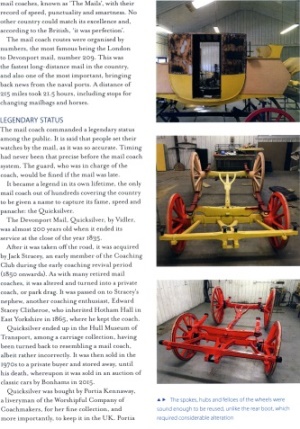
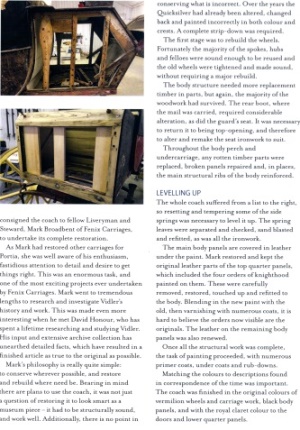
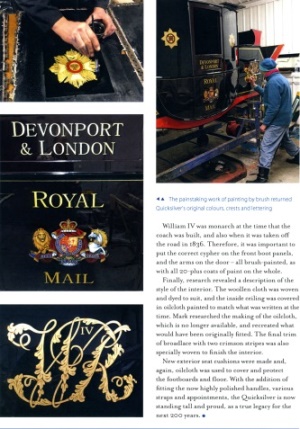

Buffet Supper
February 2019, HMS President, St Katharine's Way, London
Menu
Filo Pastry Parcels of
Spinach English Cod & Pea Puree
Lemon Grass Sauce
or
Feather Blade of English Beef
Wild Mushroom & Yellow Carrots
Rich Red Onion Gravy
Old Fashioned Potatoes
Honey Glazed Root Vegetables
Bowls of Salad
Thai Jasmine Rice Salad with Pink Peppercorn
Marinated Black Olive with Greek Feta Cheese
Baby Gem Lettuce with Confit Red & Yellow Pepper
&&&
Kumquat Mousse with Orange Chips
Chocolate Brownies Cheese Cake
&&&
Fair Trade Rich Roast Coffee
Tregothnan Cornish Estate Grown Tea
Wines
José Michel Brut NVJosé Michel & Fils Moussy, near Epernay
Picpoul de Pinet, Domaine la Serre 2016
Merlot, IGP Pays d'Oc 2016 Domaine Bergon, Vias
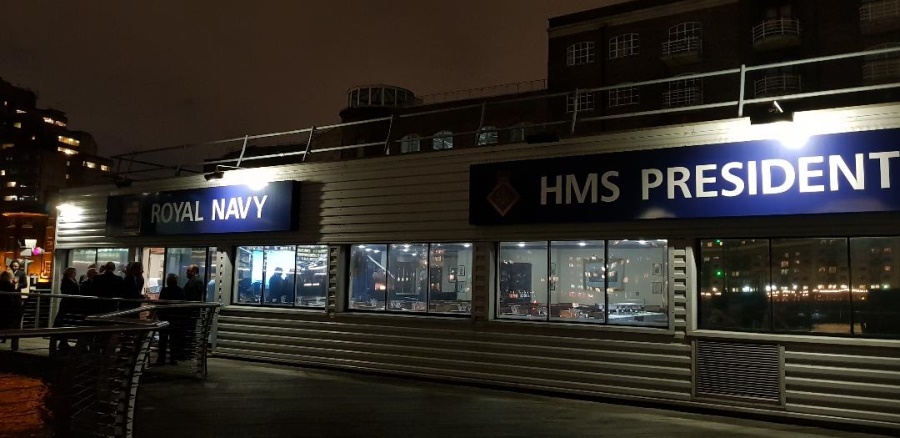
Receiving the latest news on The Royal Nay from the Presentation Team
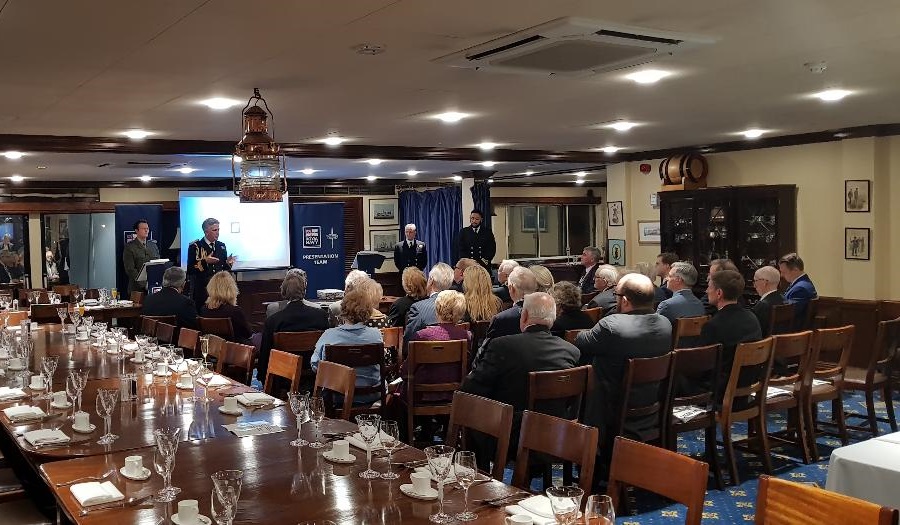
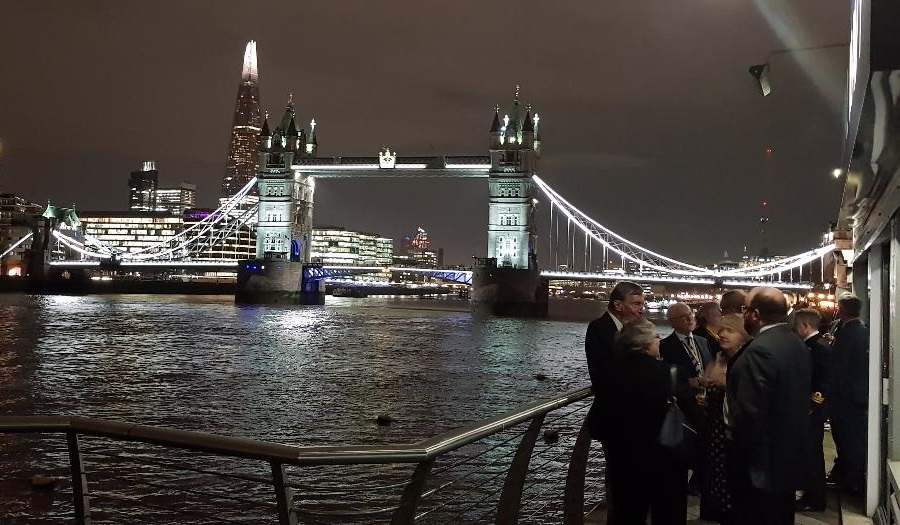

City Livery RAF Centenary Banquet
April 2018, Guildhall, City of London
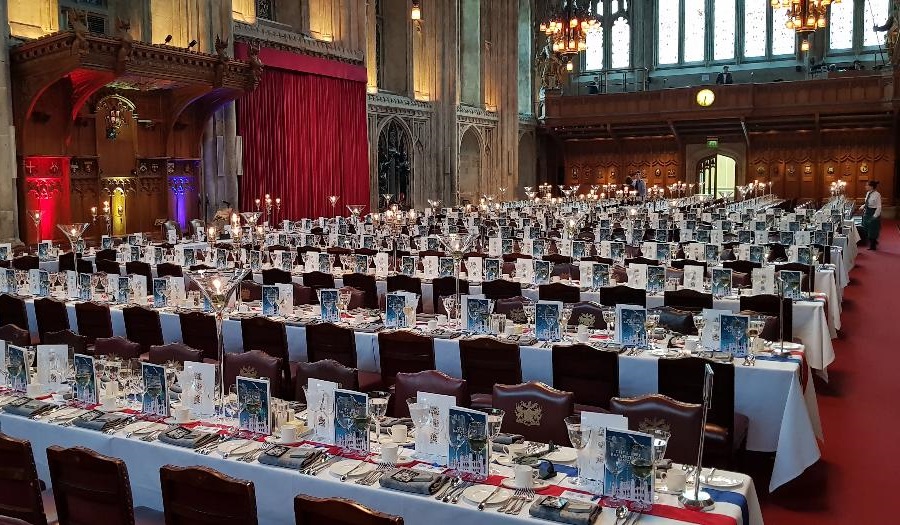
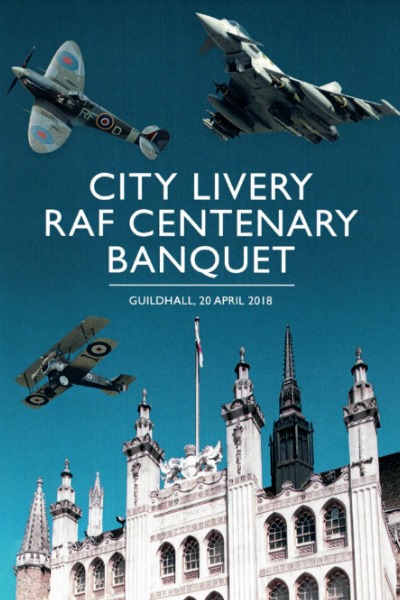
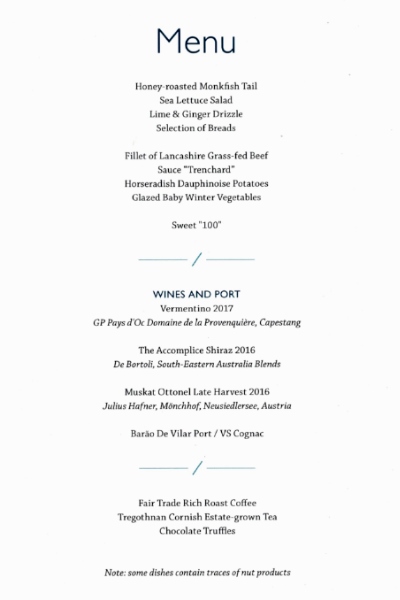
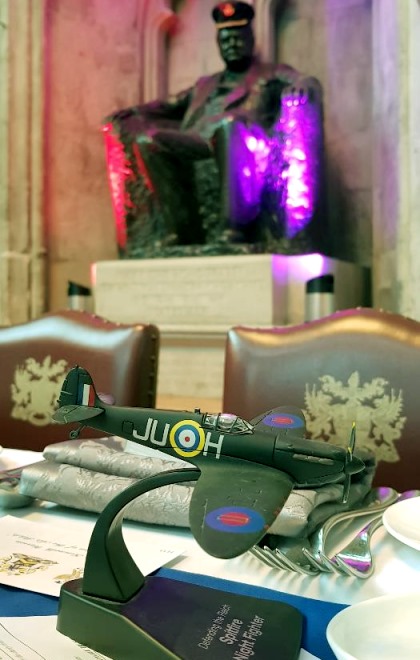
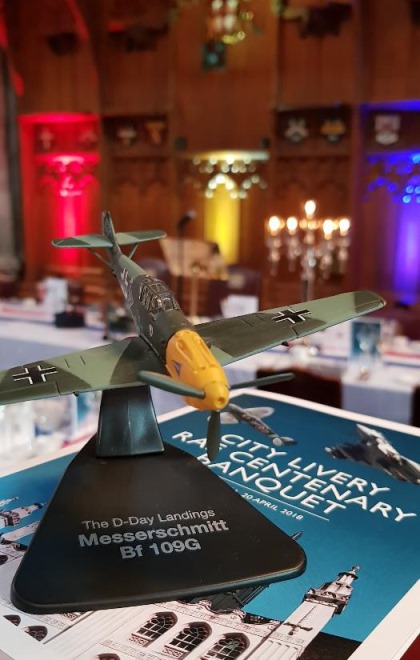
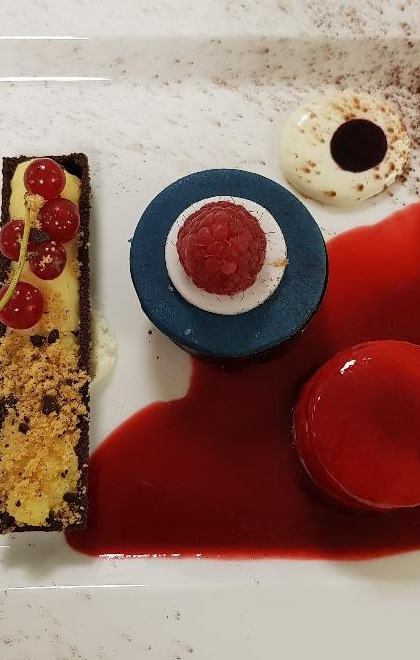
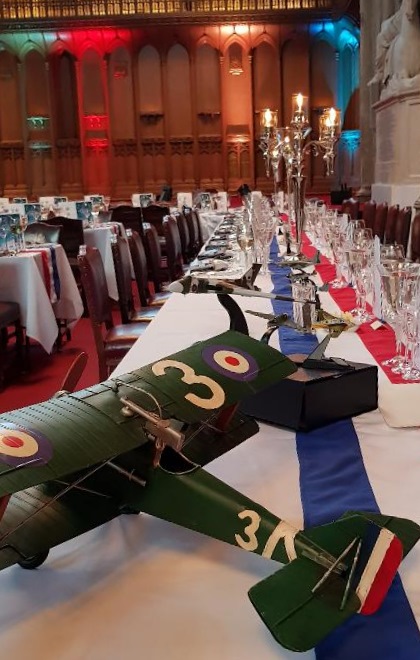
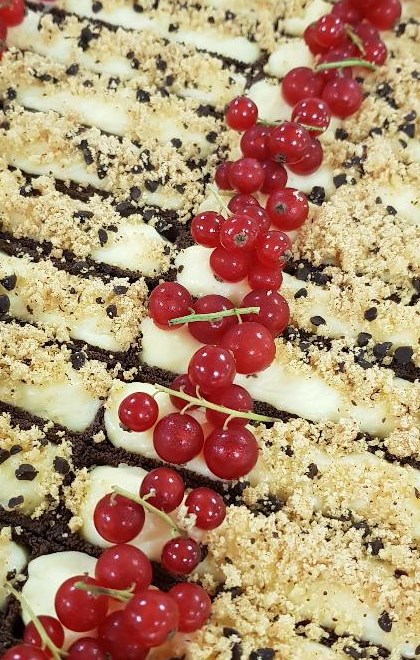

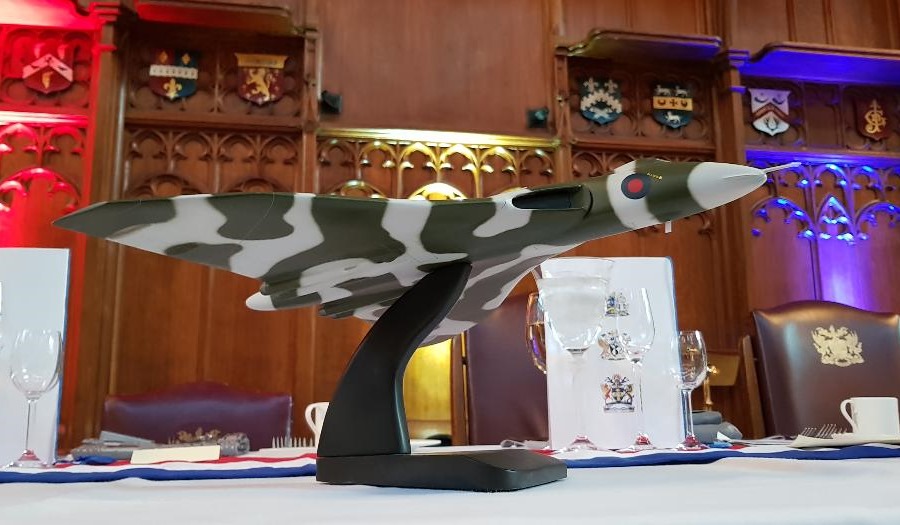

The Banquet, Guildhall, City of London, June 2013
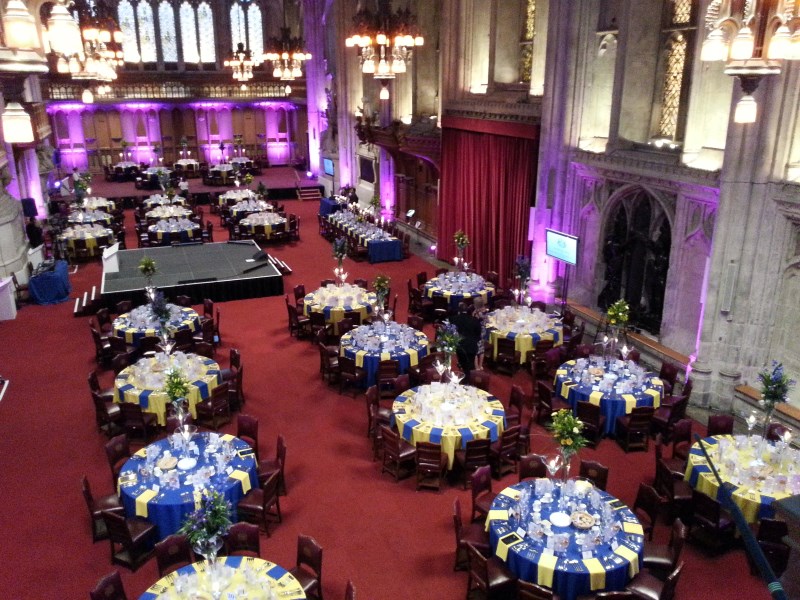
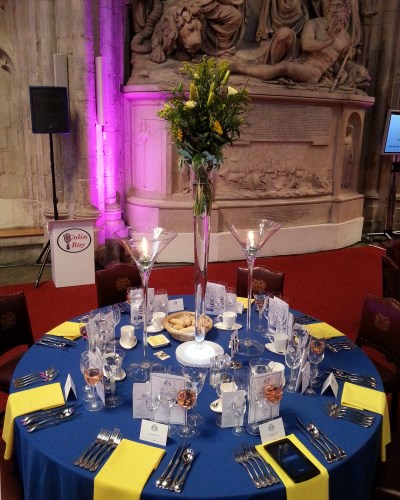
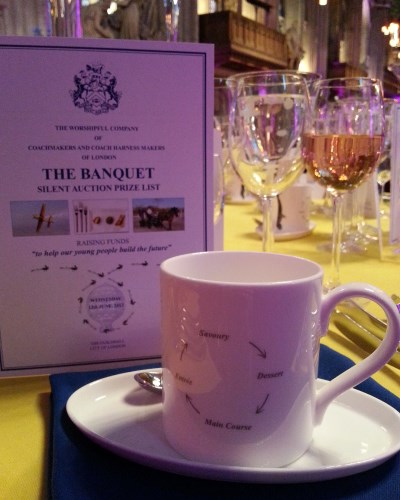
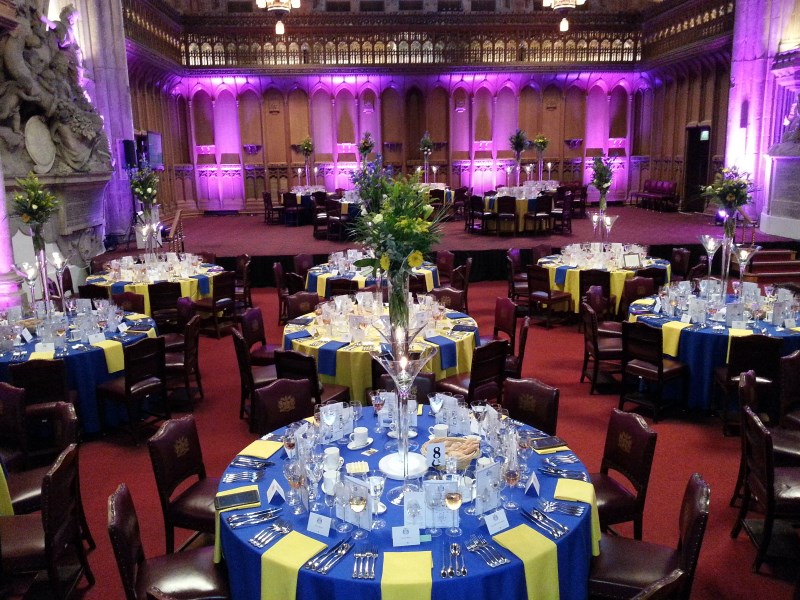
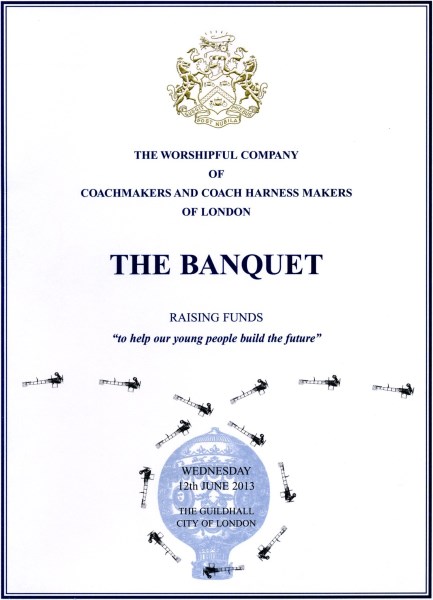
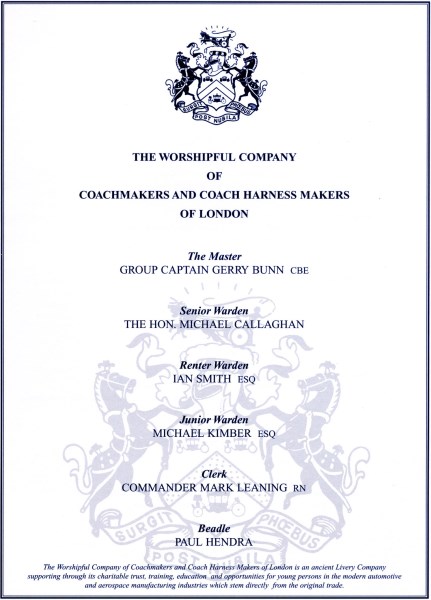
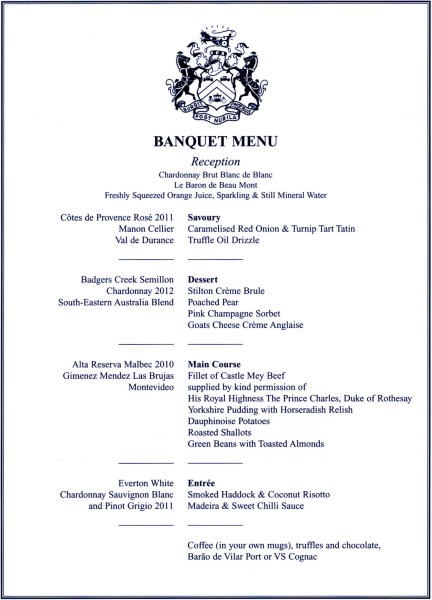
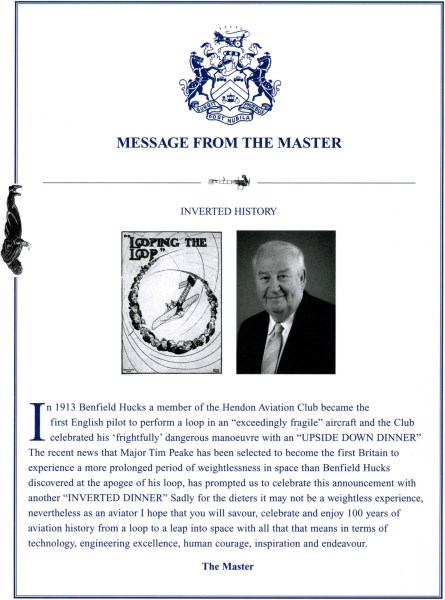
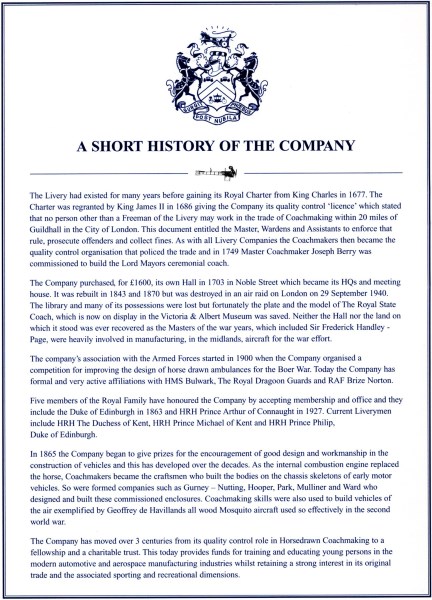
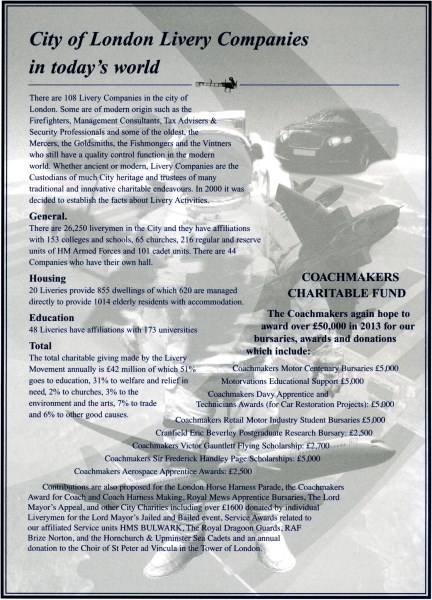
COACHMAKERS CHARITABLE FUND
The Coachmakers again hope to award over £50,000 in 2013 for our bursaries,
awards and donations which include:
Coachmakers Motor Centenary Bursaries £5,000
Motorvations Educational Support £5,000
Coachmakers Davy Apprentice and Technicians Awards (for Car Restoration
Projects): £5 ,000
Coachmakers Retail Motor Industry Student Bursaries £5,000
Cranfield Eric Beverley Postgraduate Research Bursary: £2,500
Coachmakers Victor Gauntlett Flying Scholarship: £2,700
Coachmakers Sir Frederick Handley Page Scholarships: £5,000
Coachmakers Aerospace Apprentice Awards: £2,500
Contributions are also proposed for the London Horse Harness Parade, the
Coachmakers Award for Coach and Coach Harness Making, Royal Mews Apprentice
Bursaries, The Lord Mayor`s Appeal, and other City Charities including over
£1600 donated by individual Liverymen for the Lord Mayor`s Jailed and Bailed
event, Service Awards related to our affiliated Service units HMS BULWARK,
The Royal Dragoon Guards, RAF Brize Norton, and the Hornchurch & Upminster
Sea Cadets and an annual donation to the Choir of St Peter ad Vincula in the
Tower of London.

The Award to Industry
Livery Dinner,
Trinity House, London, January 2011
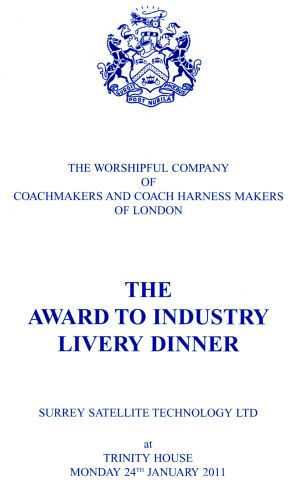
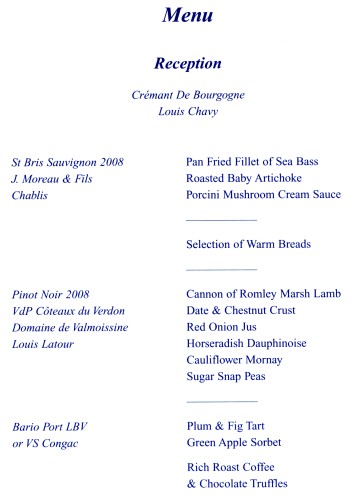
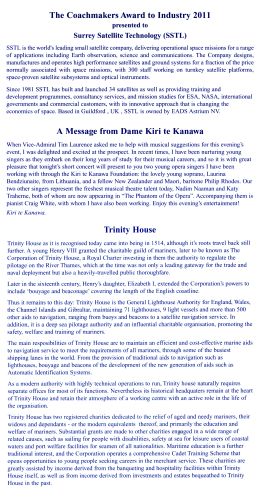
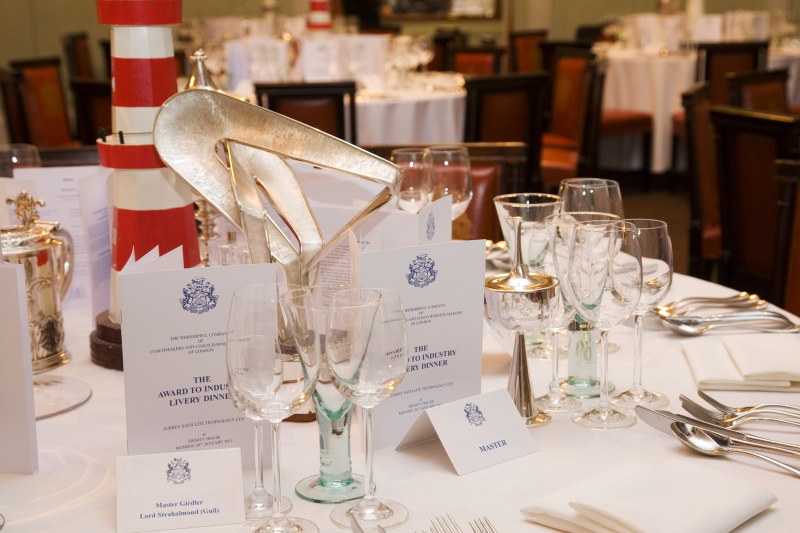

The Award to Industry Banquet in aid of
Help for
Heroes
Guildhall, London, June 2009
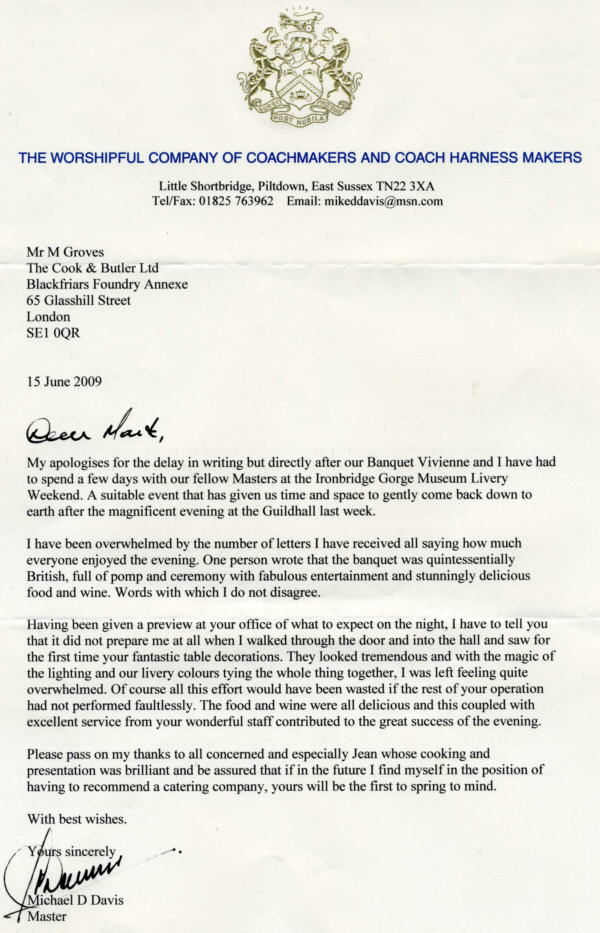
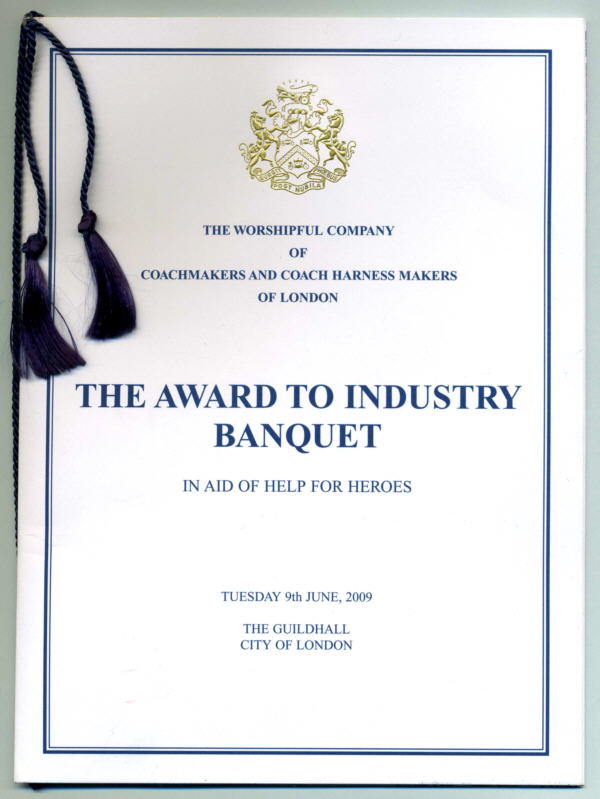
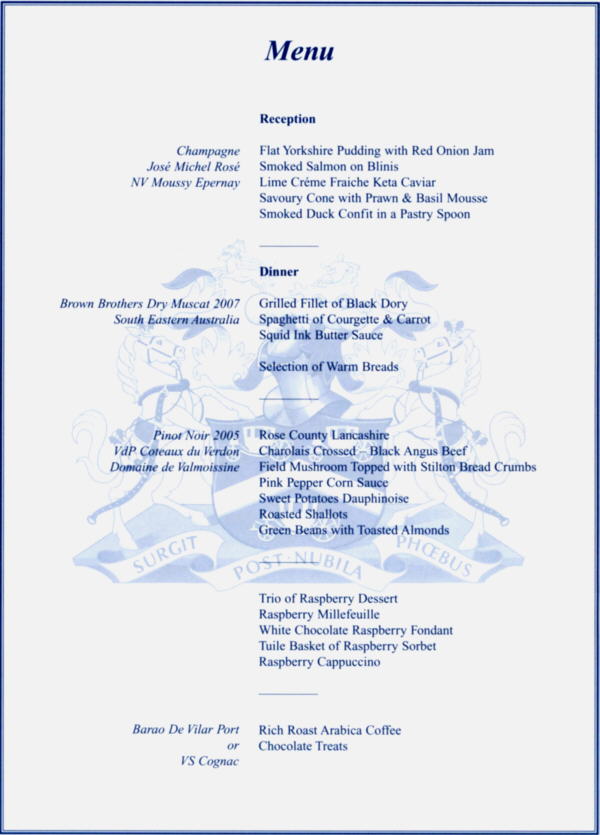
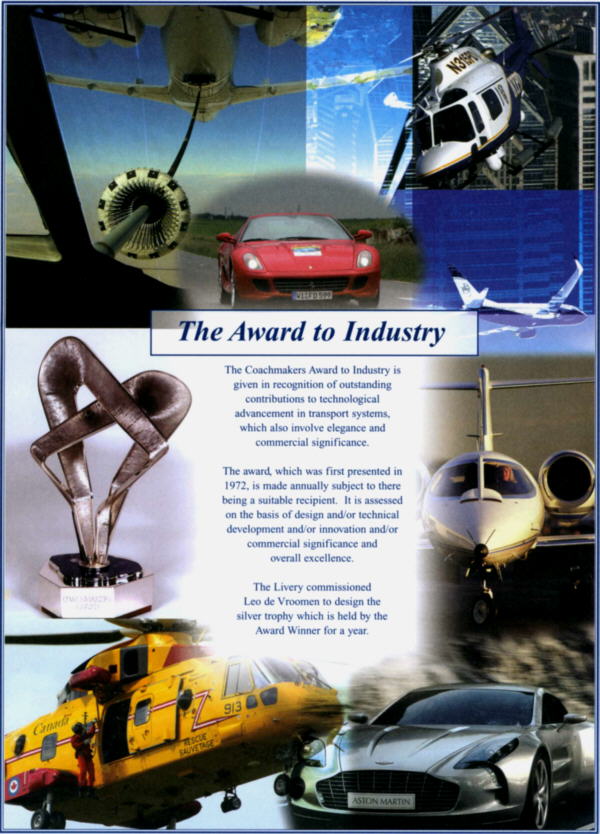
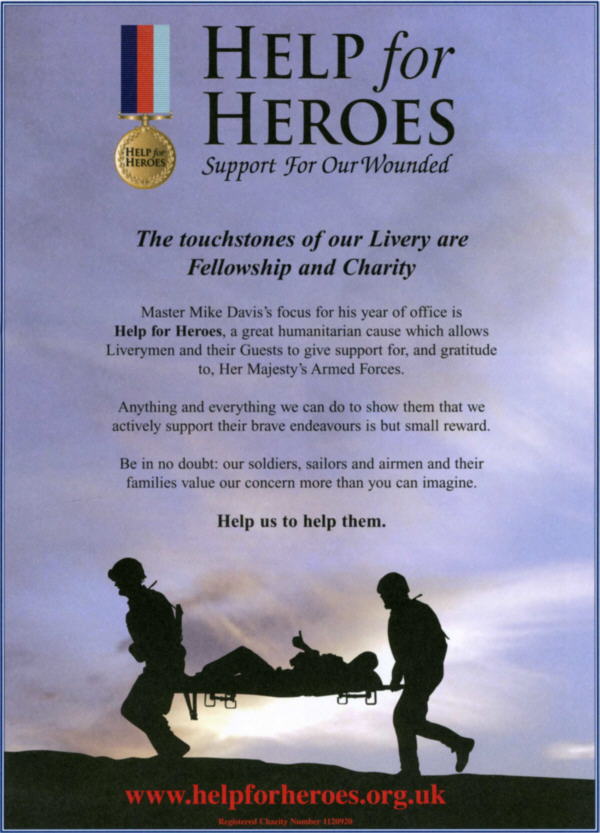
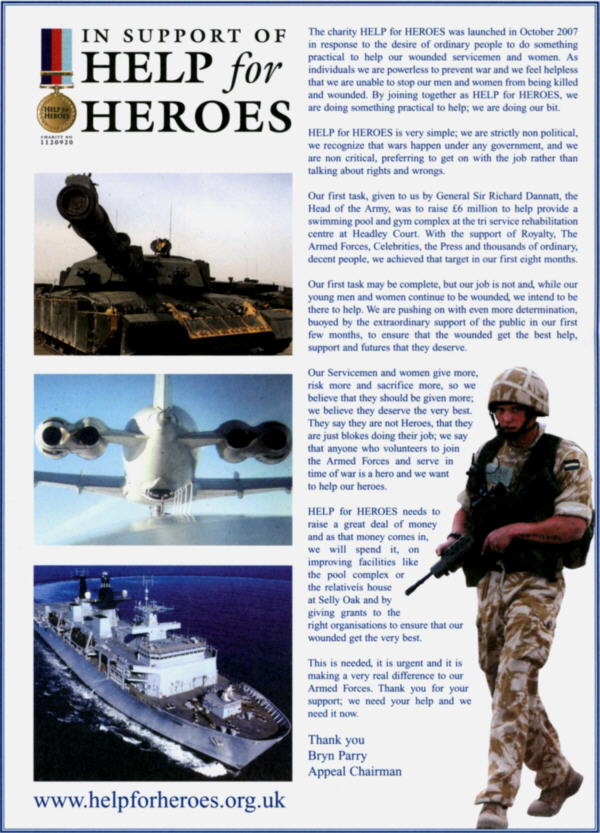
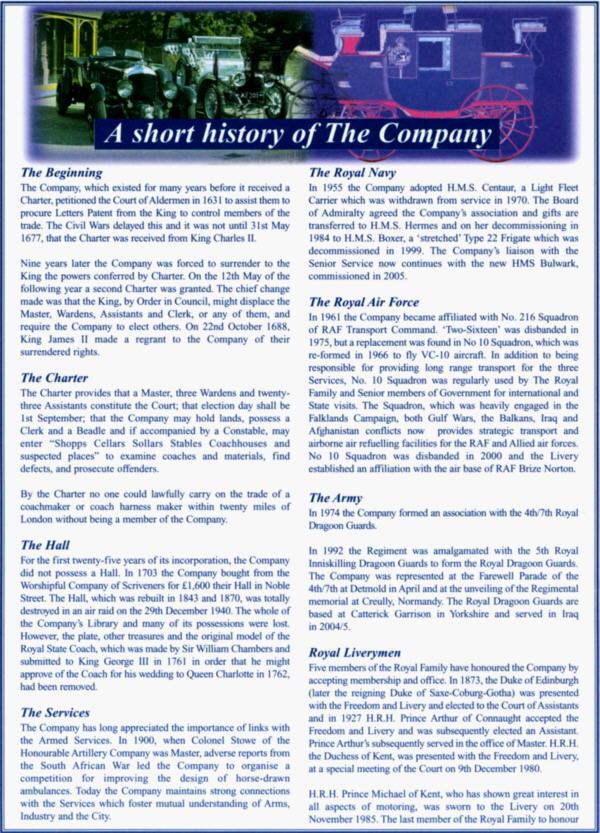
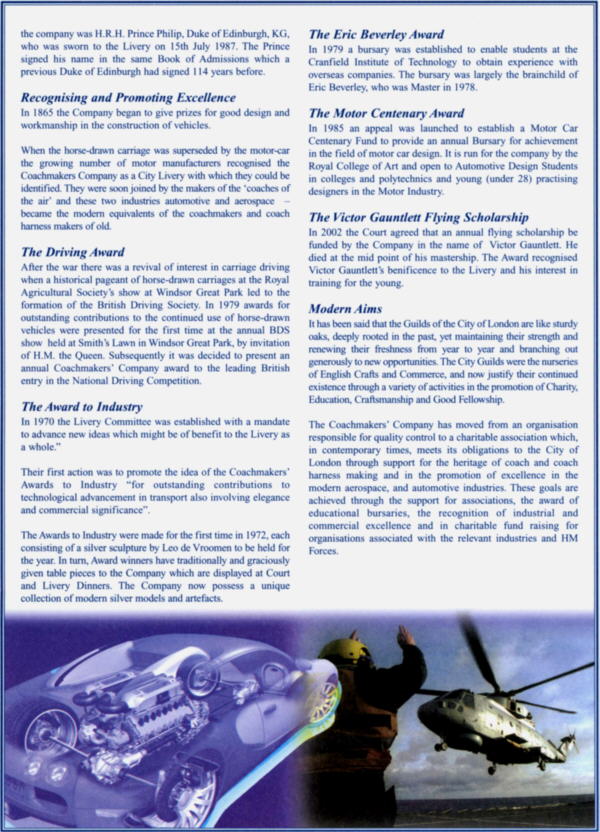
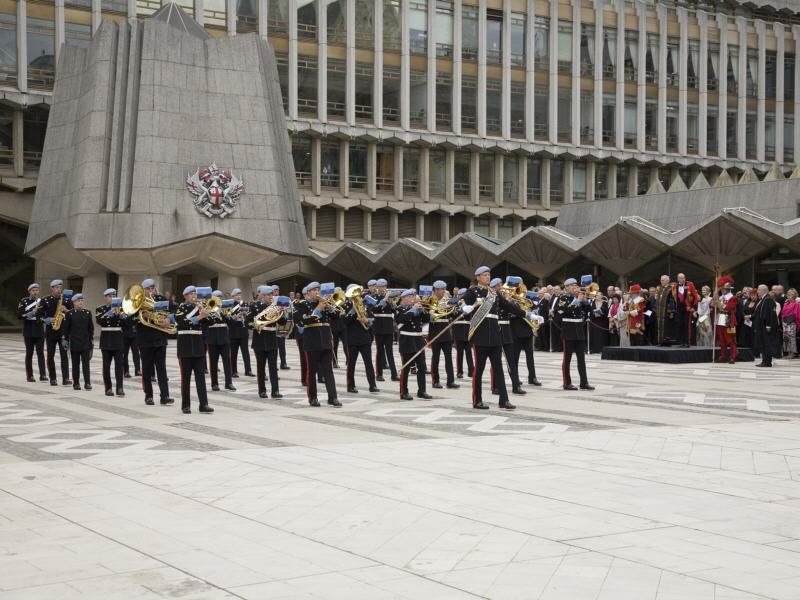
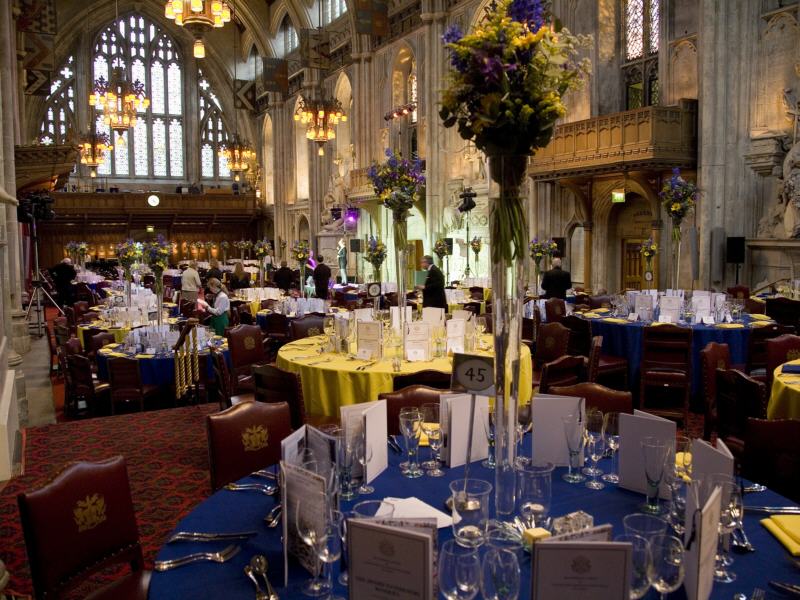
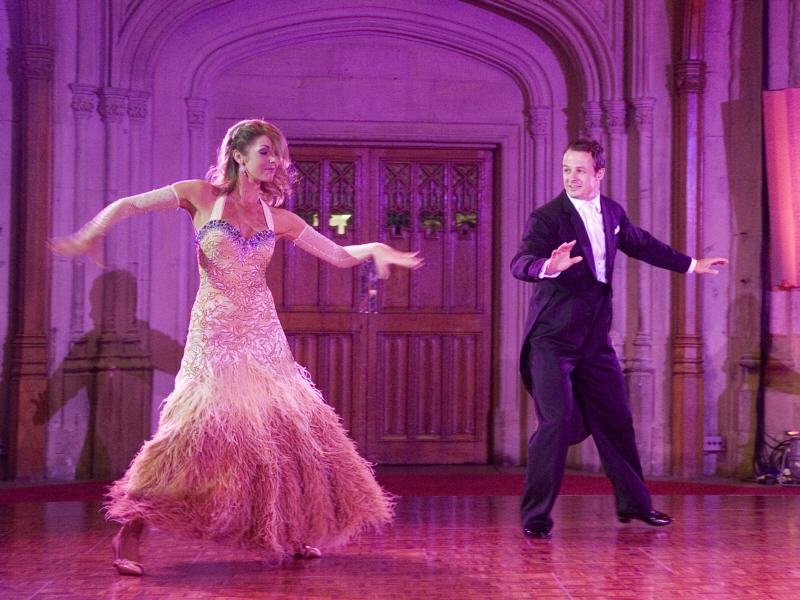
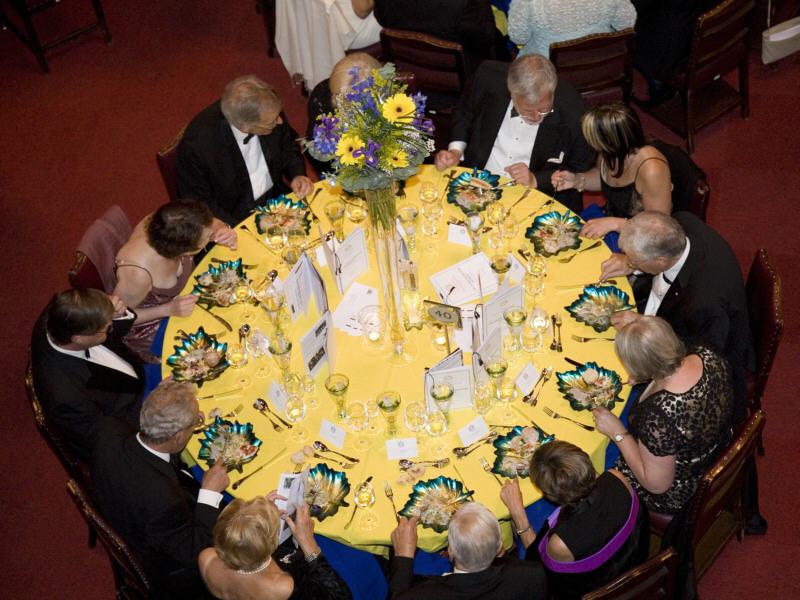

The Dinner for
Honoured Guests, Stationers' Hall, London, July 2010
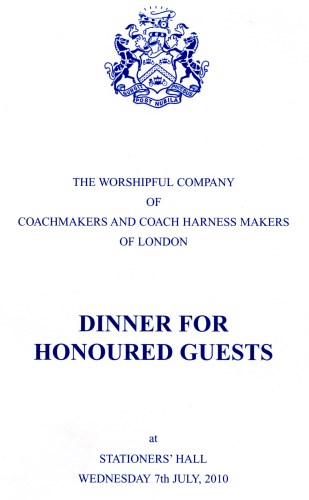
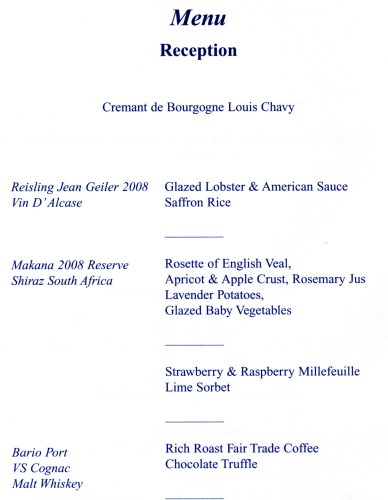
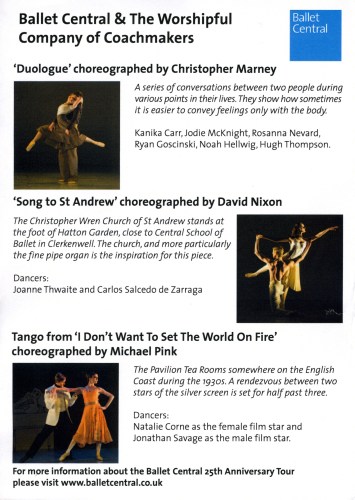
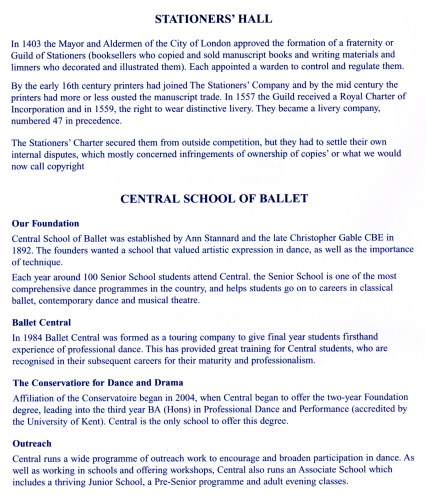

A SHORT HISTORY OF THE COMPANY
The Livery had existed for many years before gaining its Royal Charter from
King Charles in 1677. The Charter was regranted by King James 11 in 1686
giving the Company its quality control ‘licence’ which stated that no person
other than a Freeman of the Livery may work in the trade of Coachmaking
within 20 miles of Guildhall in the City of London. This document entitled
the Master. Wardens and Assistants to enforce that rule, prosecute offenders
and collect fines. As with all Livery Companies the Coachmakers then became
the quality control organisation that policed the trade and in 1749 Master
Coachmaker Joseph Berry was commissioned to build the Lord Mayors ceremonial
coach.
The Company purchased, for £l600, its own Hall in 1703 in Noble Street which
became its HQs and meeting house. It was rebuilt in 1843 and 1870 but was
destroyed in an air raid on London on 29 September 1940. The library and
many of its possessions were lost but fortunately the plate and the model of
The Royal State Coach, which is now on display in the Victoria & Albert
Museum was saved. Neither the Hall nor the land on which it stood was ever
recovered as the Masters of the war years, which included Sir Frederick
Handley - Page, were heavily involved in manufacturing, in the midlands,
aircraft for the war effort.
The company's association with the Armed Forces started in 1900 when the
Company organised a competition for improving the design of horse drawn
ambulances for the Boer War. Today the Company has formal and very active
affiliations with HMS Bulwark, The Royal Dragoon Guards and RAF Brize
Norton. Five members of the Royal Family have honoured the Company by
accepting membership and office and they include the Duke of Edinburgh in
1863 and HRH Prince Arthur of Connaught in 1927. Current Liverymen include
HRH The Duchess of Kent, HRH Prince Michael of Kent and HRH Prince Philip,
Duke of Edinburgh.
In 1865 the Company began to give prizes for the encouragement of good
design and workmanship in the construction of vehicles and this has
developed over the decades. As the internal combustion engine replaced the
horse, Coachmakers became the craftsmen who built the bodies on the chassis
skeletons of early motor vehicles. So were formed companies such as Gurney -
Nutting, Hooper, Park, Mulliner and Ward who designed and built these
commissioned enclosures. Coachmaking skills were also used to build vehicles
of the air exemplified by Geoffrey de Havillands all wood Mosquito aircraft
used so effectively in the second world war.
The Company has moved over 3 centuries from its quality control role in
Horsedrawn Coachmaking to a fellowship and a charitable trust. This today
provides funds for training and educating young persons in the modern
automotive and aerospace manufacturing industries whilst retaining a strong
interest in its original trade and the associated sporting and recreational
dimensions.
![]()
